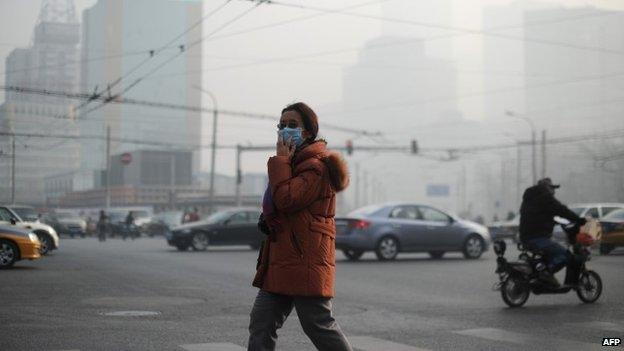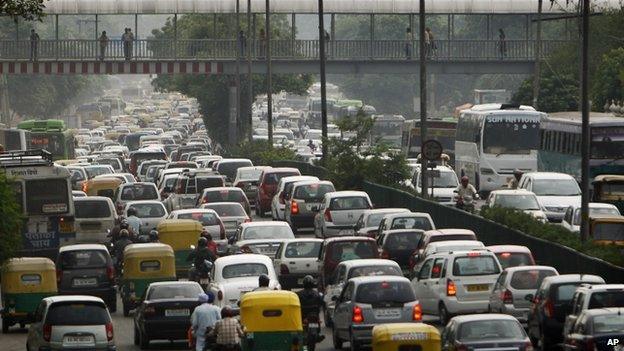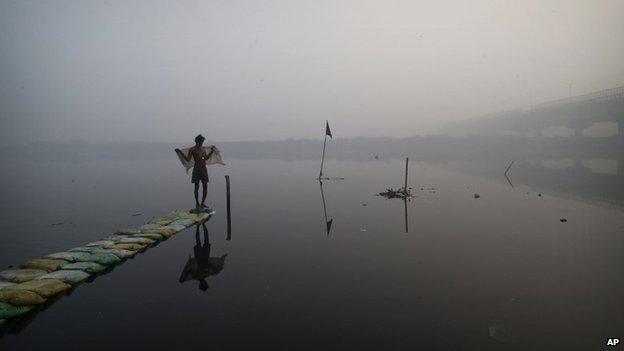Why Delhi is losing its clean air war
- Published

Delhi's air quality is getting worse and little is being done to stop it, say experts
The US-based Environmental Preference Index has denied media reports, external suggesting it found air quality in Delhi worse than in Beijing. But while China's capital appears to be slowly turning the pollution clock back, India's first city seems to have given up the fight for clean air, reports Jay Mazoomdaar.
When recent media reports claimed that New Delhi was breathing in more pollution than Beijing, government agencies in India promptly dismissed it as hot air.
Even before Dr Angel Hsu, principal investigator of the 2014 Environmental Performance Index (EPI), external clarified that EPI did not rank New Delhi and Beijing for want of comparable data, India's government, the Delhi Pollution Control Committee and the city-based think tank Centre for Science and Environment (CSE) made claims and counter claims on air pollution levels in the two cities.
The jury is still out.
"Worse than Beijing's or not, Delhi's air quality is certainly very poor and only getting worse. But our authorities have done little to reverse the trend, partly because public awareness is far from adequate," says Ravi Aggarwal, director of the NGO, Toxic Links.
Too little, too lax
In stark contrast to Beijing where levels of PM10 (particulate matter up to 10 micrometres in size) decreased by about 40% between 2000 and 2013, Delhi's PM10 levels have gone up by about 47% from 2000 to 2011.
The result is that Delhi's PM10 levels are nearly twice as much as in Beijing.
Last year, the Beijing Environmental Protection Bureau announced plans to invest 300bn yuan to reduce levels of PM2.5 (which is more harmful than PM10 as it penetrates deeper into the lung) to 60 microgram/cum in five years.

Beijing has taken a number of steps to check pollution
The levels of PM2.5 in Delhi are on the rise, from 168 m/cum in January 2011 to 183 m/cum last month.
To turn the pollution clock back, Beijing has brought down the number of cars that can be sold in a year, denied any significant price advantage to diesel cars, introduced Euro V standards, invested in public transport and reined in polluting industries.
China is also imposing heavy fines on local governments that fail to keep air pollution at sub-critical levels.
Delhi, in fact, had a head-start in 2000, external when compressed natural gas (CNG) was made mandatory for buses and three wheelers, or auto rickshaws.
Since then, the city has taken old commercial vehicles off the road, introduced Euro IV emission standards, set up intra-city metro railways and added a new fleet of buses to expand public transport.
The city government also moved out polluting factories, introduced stricter norms for power plants and banned open burning of refuse and leaves.
But either the scale of intervention or the enforcement has been inadequate.
Cars, kilns and fireworks
The CNG advantage was soon squandered due to Delhi's ever expanding fleet of more than eight million vehicles.
"Parking is virtually free in Delhi. There is no congestion tax; no incentive for petrol-run cars. Public transport lacks feeder services and last mile connectivity. Heavy traffic makes cars crawl and spew more fumes. The pollution levels are now worse than pre-CNG days," says Anumita Roy Chowdhury, executive director of CSE.

Delhi has more than eight million vehicles
In an ever expanding Delhi, the dumping of massive quantities of construction waste is a major reason for heavy dust pollution. As is substantial loss of city forests that once stood in the way of dusty winds from the arid west.
Between November and February, air pollution levels peak anyway due to a drop in temperature and frequent calm wind conditions. A string of seasonal activities in and around Delhi makes it far worse.
More than 1,000 brick kilns that cater to Delhi's construction boom burn away within 20km (12 miles) of the city during the dry winter spell, according to Dr Sarath Guttikunda, director of Urban Emissions Info.
Agricultural waste is set on fire across thousands of hectares around Delhi to clear cropland, which burns for days on end.
Massive quantities of fireworks go up in smoke during the festival of Diwali and year-end celebrations. The city's poor and homeless burn rubbish to stay warm at night.

Air pollution levels in Delhi peak between November and February
Breathing this poison keeps Delhi chronically sick.
The 2013 Global Burden of Disease, external report identified air pollution, a Class 1 carcinogen according to the World Health Organisation, as the fifth largest killer in India where more people die of asthma than anywhere else in the world. Air pollution is also a trigger for heart attack and cancer.
In 2008, the Central Pollution Control Board, external studied 11,628 children from 36 schools in Delhi and found reduced lung function in 43.5% of them.
In 2013, the World Allergy Organisation, external reported high respiratory disorder symptoms in students residing in north (66%), west (59%) and south (46%) Delhi.
Yet, Delhi Pollution Control Commitee official Sandeep Mishra admits that an "action plan" to fight air pollution has been on hold since 2012.
Air quality is also not on the 17-point agenda of the new Delhi government under anti-corruption crusader Arvind Kejriwal who took the oath in late December when air pollution levels had peaked.
"Mr Kejriwal has not recovered from a cough and cold ever since he took charge as the chief minister. If anyone, he understands the city's respiratory problems," quipped a senior health official.
Jay Mazoomdaar is an independent journalist who writes for publications in India and abroad.
- Published6 January 2014
- Published24 December 2013
- Published9 November 2012
- Published8 November 2012